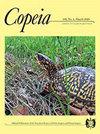在Rubí毒蛙Andinobates bombetes(毛虫科)中栖息
IF 2.6
Q2 Agricultural and Biological Sciences
引用次数: 6
摘要
归巢是一种行为,指动物在移动或迁移到一个遥远的地方后回到一个特定的地方。在无尾动物中,我们关于归巢的大部分知识来自对温带地区物种的研究,这些物种夜间活动和繁殖与池塘有关。最近,对毒蛙(石蛙科)的研究增加了我们对热带青蛙的认识,这些青蛙白天活动,不在大池塘里繁殖。Rubí毒蛙Andinobates bombetes为进一步增加无尾动物归巢行为生态学的知识提供了一个很好的机会,因为该物种的一些自然历史特征不同于大多数已经研究过归巢能力的毒蛙。例如,a . bombette有一个较小的身体大小,并利用凤梨中的植物端藻来发育蝌蚪,而其他的则利用陆地池塘。为了量化bombeta的归巢能力及其影响因素,我们在位于哥伦比亚中部安第斯山脉Quindío的森林遗迹中,对其领地外5 ~ 90 m的个体进行了易位实验。在这项研究中,我们纳入了大量的雌性样本,这很重要,因为毒蛙的归巢研究几乎完全是在领地雄性中进行的。在104名流离失所者中,39人返回其领土。蜂的归巢概率与易位距离呈负相关,而与体型和性别无关。显然,与迄今为止研究的大多数毒蛙相比,这种物种的归巢能力有限,除了O. pumilio,后者在体型和用于繁殖的资源上似乎更相似。总的来说,在石斛科中,归巢能力似乎是广泛共享的,Andinobates是这个科的第四个属,它的归巢能力已经被实验证实。本文章由计算机程序翻译,如有差异,请以英文原文为准。
Homing in the Rubí Poison Frog Andinobates bombetes (Dendrobatidae)
Homing is a behavior in which an animal returns to a specific place after they have moved or migrated to a distant place. In anurans, most of our knowledge about homing comes from studies in temperate-region species with nocturnal activity and reproduction associated with ponds. Recently, studies with poison frogs (Dendrobatidae) have increased our understanding about homing in tropical frogs with diurnal activity, and that do not breed in large ponds. The Rubí Poison Frog Andinobates bombetes offers a good opportunity to further increase the knowledge of behavioral ecology of homing in anurans because some natural history traits in this species differ from those exhibited in most poison frogs in which homing ability has been studied. For instance, A. bombetes have a smaller body size and use phytotelmata in bromeliads for tadpole development while others use terrestrial pools. To quantify the homing ability and the factors influencing it in A. bombetes, we performed translocation experiments of individuals at distances between 5 and 90 m outside their territory in a forest remnant located in the department of Quindío, Central Andes of Colombia. In this study, we included a large sample size of females, which is important because homing studies with poison frogs has been almost exclusively studied in territorial males. Of 104 displaced individuals, 39 returned to their territory. The probability of homing in A. bombetes was negatively related to the translocation distance, but was unrelated to body size and sex. Apparently, this species has a limited homing ability when compared to most poison frogs studied so far except for O. pumilio, which seems more similar in body size and resources used for reproduction. Overall, homing ability appears to be widely shared in the family Dendrobatidae, Andinobates being the fourth genus of this family for which homing ability has been corroborated experimentally.
求助全文
通过发布文献求助,成功后即可免费获取论文全文。
去求助
来源期刊

Copeia
生物-动物学
CiteScore
2.10
自引率
0.00%
发文量
0
审稿时长
6-12 weeks
期刊介绍:
Founded in 1913, Copeia is a highly respected international journal dedicated to the publication of high quality, original research papers on the behavior, conservation, ecology, genetics, morphology, evolution, physiology, systematics and taxonomy of extant and extinct fishes, amphibians, and reptiles. Copeia is published electronically and is available through BioOne. Articles are published online first, and print issues appear four times per year. In addition to research articles, Copeia publishes invited review papers, book reviews, and compiles virtual issues on topics of interest drawn from papers previously published in the journal.
 求助内容:
求助内容: 应助结果提醒方式:
应助结果提醒方式:


